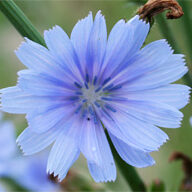Latin name: Cichorium intybus
Place of origin: Europe, central Russia, and western Asia
Description: Chicory is commonly found alongside roads and in other disturbed natural habitats. It is recognizable by the blue flowers that bloom along the length of its stems (“Chicory, Cichorium intybus”).
Historical medicinal use: The roots of chicory plants have traditionally been used to treat a range of ailments, including digestive issues and a loss of appetite (Street et. al., 2013).
Modern medicinal use: Chicory roots has a long history of medicinal use, but research on its effectiveness is limited in the modern world. Regardless, many people continue to use chicory root according to traditional medicinal practices (Street, Renée A et. al., 2013).
“Chicory, Cichorium Intybus.” Wisconsin Horticulture, hort.extension.wisc.edu/articles/chicory-cichorium-intybus/. Accessed 22 Apr. 2024.
Fuchs, Leonhart. Histoire des plantes. 1549
Street, Renée A et al. “Cichorium intybus: Traditional Uses, Phytochemistry, Pharmacology, and Toxicology.” Evidence-based complementary and alternative medicine : eCAM vol. 2013 (2013): 579319. doi:10.1155/2013/579319

